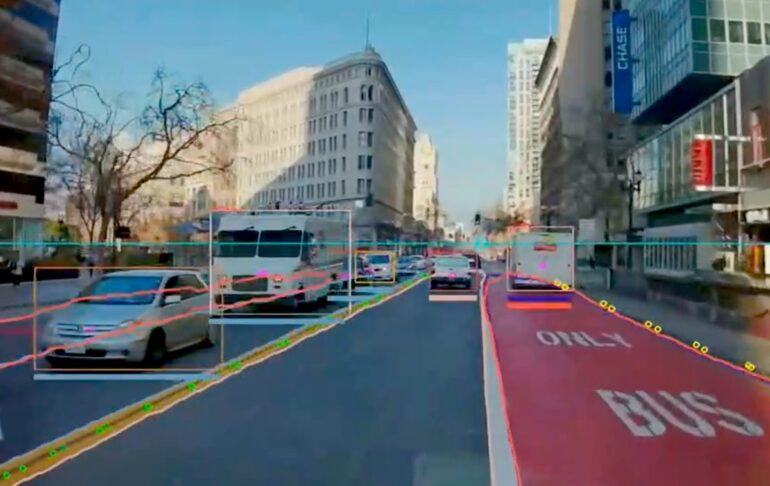TL;DR:
- AC Transit adopts AI technology to deter unauthorized vehicles obstructing bus lanes and stops.
- Cameras with AI capabilities continuously monitor traffic, capturing crucial data for enforcement.
- Safety of riders, especially the elderly and ADA passengers, is a key motivation.
- AI-generated evidence packages are automatically sent to law enforcement for violations.
- Improved operational punctuality is anticipated through proactive obstruction identification.
- Assembly Bill 917 empowers California transit agencies to use AI cameras for enforcement.
- Previous limitations, like SB 1051, hindered efficiency due to manual driver involvement.
- AI system shows impressive results with 99% accuracy in identifying violations.
- AI cameras are not designed to address moving violations like speeding.
- Similar technology success is seen in San Francisco’s Muni and New York’s MTA.
Main AI News:
The AC Transit, a prominent player in the public transportation sector of Alameda and Contra Costa counties, is set to revolutionize its operational efficiency through the integration of artificial intelligence into its surveillance systems. With an innovative approach, AC Transit aims to curtail the issue of unauthorized vehicles obstructing designated bus lanes, stops, and transit centers. This strategic move not only reflects the organization’s commitment to passenger safety but also highlights its dedication to embracing cutting-edge technology.
Robert Lyles, the proficient Communications Director of AC Transit, elaborates on the primary objective behind this transformative initiative, emphasizing the protection of all riders, particularly those who are elderly or individuals with disabilities, during the crucial processes of boarding and disembarking. This innovative utilization of AI technology has been successfully demonstrated through the installation of specialized cameras within AC Transit buses, a practice that has already undergone a successful “proof-of-concept” phase.
Hayden AI, the distinguished manufacturer of revolutionary cameras and software, reveals that these sophisticated cameras are strategically mounted within the bus windshields, enabling them to perpetually monitor traffic. The cameras efficiently capture a multitude of crucial data, including images, video footage, license plate information, and other pertinent details. Upon detecting any violation, the AI system promptly assembles an “evidence package” that is swiftly forwarded to law enforcement agencies. A captivating demonstration on Hayden AI’s website exhibits the AI system’s prowess as it keenly observes vehicular movement along Broadway in downtown Oakland.
This visionary implementation of AI technology not only ensures passengers’ safety but also holds the potential to significantly enhance AC Transit’s operational punctuality. By proactively identifying and addressing obstructions caused by improperly parked vehicles, bus drivers can circumvent unnecessary slowdowns or prolonged waits, thus ensuring smoother traffic flow.
AC Transit, a paragon of innovation in the transit industry, has kept its future plans under wraps regarding the broader integration of AI-equipped cameras across multiple bus lines. However, the organization has underscored its commitment to transparency, asserting that it will promptly notify riders and the community about the expanded deployment beyond the pilot phase. It’s important to note that, during the initial 60 days of deployment, individuals found parking in designated bus lanes will receive warnings, indicating a gradual transition to full enforcement.
In the context of legal frameworks, Assembly Bill 917, enacted last year, holds paramount significance. This legislation has empowered all California transit agencies, including AC Transit, to harness the potential of AI-driven camera systems for the enforcement of parking violations in bus lanes and transit stops. Notably, the legislation encompasses advanced camera systems that can independently identify violations without the need for human intervention.
The significance of this legislative stride becomes evident when juxtaposed with the prior limitations set by laws like SB 1051. Preceding AB 917, only a limited number of transit agencies were authorized to use front-facing cameras for identifying and penalizing illegally parked vehicles. However, the technology’s efficiency was often hindered by the need for manual input from bus drivers, impeding traffic flow. This resulted in a mere 4% of suspected violators receiving citations, as per AC Transit’s data.
This transformation was driven by a necessity for dependable and efficient technology that relieves bus operators from enforcement responsibilities while enhancing the precision of violation identification. As demonstrated in a recent testing phase on two Tempo buses, the new AI camera system exhibited remarkable results, flagging an average of nine violations per day over a 48-day period. Impressively, the system achieved a staggering 99% accuracy in identifying illegally parked vehicles.
However, it’s important to acknowledge that these AI cameras are not designed to address moving violations such as speeding, which holds a pivotal position in traffic safety discourse due to its potential for catastrophic consequences. While the system’s capabilities are formidable, certain aspects of traffic enforcement remain outside its current scope.
The landscape of public transportation enforcement is rapidly evolving, with AC Transit joining the ranks of progressive systems like San Francisco’s Muni and New York City’s MTA. These pioneers have long embraced technology to enforce bus lane regulations, resulting in enhanced operational efficiency. This tech-driven paradigm shift has proven its worth, as evidenced by a policy analysis of Muni’s camera citation system, which led to a remarkable reduction of transit delays by up to 20%.
Conclusion:
AC Transit’s innovative integration of AI into its surveillance systems for enforcing bus lane regulations signifies a transformative shift in public transportation operations. The organization’s adoption of cutting-edge technology to enhance passenger safety, operational efficiency, and regulatory enforcement sets a precedent for the market. This strategic move may stimulate further technological advancements in the public transit sector, influencing other agencies to embrace AI-driven solutions for optimal performance and safety.

